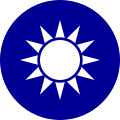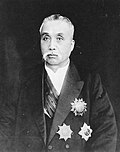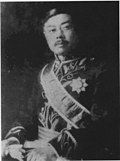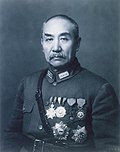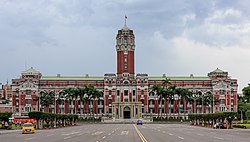No. Portrait Name(Birth–Death) Term of office Political party Vice President Assembly 1 Sun Yat-sen 孫中山 (1866–1925) 1 January 1912 10 March 1912 Tongmenghui Li Yuanhong (Independent ) Provisional (1911 ) 2 Yuan Shikai 袁世凱 (1859–1916) 10 March 1912 10 October 1913 Beiyang clique Li Yuanhong (Independent ) Provisional (1912 ) No. Portrait Name(Birth–Death) Term of office Political party Vice President Assembly 1 Yuan Shikai 袁世凱 (1859–1916) 10 October 1913 6 June 1916 [ note 2] [ note 3] Beiyang clique Li Yuanhong (Progressive ) 1st (1913 ) 2 Li Yuanhong 黎元洪 (1864–1928) 7 June 1916 17 July 1917 [ note 4] [ note 5] Progressive Party Feng Guozhang (Zhili clique ) — Feng Guozhang 馮國璋 (1859–1919) (acting) [ note 6] 17 July 1917 10 October 1918 Zhili clique Vacant 3 Xu Shichang 徐世昌 (1855–1939) 10 October 1918 2 June 1922 [ note 5] Anhui clique Vacant 2nd (1918 ) — Zhou Ziqi 周自齊 (1871–1923) (acting) [ note 7] 2 June 1922 11 June 1922 Communications Clique Vacant (2) Li Yuanhong 黎元洪 (1864–1928) 11 June 1922 13 June 1923 [ note 5] Research Clique Vacant — Gao Lingwei 高凌霨 (1868–1939) (acting) [ note 8] 14 June 1923 10 October 1923 Zhili clique Vacant 4 Cao Kun 曹錕 (1862–1938) 10 October 1923 2 November 1924 [ note 5] Zhili clique Vacant (1923 ) — Huang Fu 黃郛 (1883–1936) (acting) [ note 7] 2 November 1924 24 November 1924 Nonpartisan Vacant 5 Duan Qirui [ note 9] 段祺瑞 (1865–1936) 24 November 1924 20 April 1926 [ note 5] Anhui clique Vacant Vacant — Hu Weide [ note 10] 胡惟德 (1863–1933) (acting) [ note 7] 20 April 1926 13 May 1926 Zhili clique Vacant — Yan Huiqing(W.W. Yan) 顏惠慶 (1877–1950) (acting) [ note 8] 13 May 1926 22 June 1926 Nonpartisan Vacant — Du Xigui 杜錫珪 (1875–1933) (acting) [ note 7] 22 June 1926 1 October 1926 Zhili clique Vacant — V.K. Wellington Koo 顧維鈞 (1888–1985) (acting) [ note 8] 1 October 1926 17 June 1927 [ note 11] Nonpartisan Vacant 6 Zhang Zuolin [ note 12] 張作霖 (1875–1928) 18 June 1927 4 June 1928 [ note 13] Fengtian clique Vacant No. Portrait Name [ note 14] (Birth–Death) Term of office Political party Assembly 1 Tan Yankai 譚延闓 (1880–1930) 7 February 1928 10 October 1928 Kuomintang 2nd National Congress of Kuomintang 2 Chiang Kai-shek 蔣中正 (1887–1975) 10 October 1928 15 December 1931 [ note 11] Kuomintang 2nd National Congress of Kuomintang — Lin Sen 林森 (1868–1943) 15 December 1931 [ note 15] 1 August 1943 [ note 3] Kuomintang 3 4th National Congress of Kuomintang — Chiang Kai-shek 蔣中正 (1887–1975) 1 August 1943 [ note 16] 20 May 1948 Kuomintang 4 5th National Congress of Kuomintang Presidents after the 1947 Constitution No. Portrait Name(Birth–Death) Term of office Political party Vice President Term 1 Chiang Kai-shek 蔣中正 (1887–1975) 20 May 1948 21 January 1949 [ note 17] Kuomintang Li Zongren (Kuomintang ) 1 (1948 ) — Li Zongren 李宗仁 (1890–1969)(acting) [ note 6] 21 January 1949 20 November 1949 Kuomintang Vacant — Yan Xishan 閻錫山 (1883–1960)(acting) [ note 8] 20 November 1949 1 March 1950 Kuomintang Vacant (1) Chiang Kai-shek 蔣中正 (1887–1975) 1 March 1950 5 April 1975 [ note 3] Kuomintang Li Zongren [ note 18] (Kuomintang ) Vacant Chen Cheng [ note 19] (Kuomintang ) 2 (1954 ) 3 (1960 ) Vacant Yen Chia-kan (Kuomintang ) 4 (1966 ) 5 (1972 ) 2 Yen Chia-kan (C. K. Yen) 嚴家淦 (1905–1993) 5 April 1975 20 May 1978 Kuomintang Vacant 3 Chiang Ching-kuo 蔣經國 (1910–1988) 20 May 1978 13 January 1988 [ note 3] Kuomintang Hsieh Tung-min (Kuomintang ) 6 (1978 ) Lee Teng-hui (Kuomintang ) 7 (1984 ) 4 Lee Teng-hui 李登輝 (1923–2020 ) 13 January 1988 20 May 2000 Kuomintang Vacant Lee Yuan-tsu (Kuomintang ) 8 (1990 ) Lien Chan (Kuomintang ) 9 (1996 ) 5 Chen Shui-bian 陳水扁 (born 1950) 20 May 2000 20 May 2008 Democratic Progressive Annette Lu (DPP ) 10 (2000 ) 11 (2004 ) 6 Ma Ying-jeou 馬英九 (born 1950) 20 May 2008 20 May 2016 Kuomintang Vincent Siew (Kuomintang ) 12 (2008 ) Wu Den-yih (Kuomintang ) 13 (2012 ) 7 Tsai Ing-wen 蔡英文 (born 1956) 20 May 2016 20 May 2024 Democratic Progressive Chen Chien-jen (Independent ) 14 (2016 ) Lai Ching-te (DPP ) 15 (2020 ) 8 Lai Ching-te 賴清德 (born 1959) 20 May 2024 Incumbent Democratic Progressive Hsiao Bi-khim (DPP ) 16 (2024 ) 